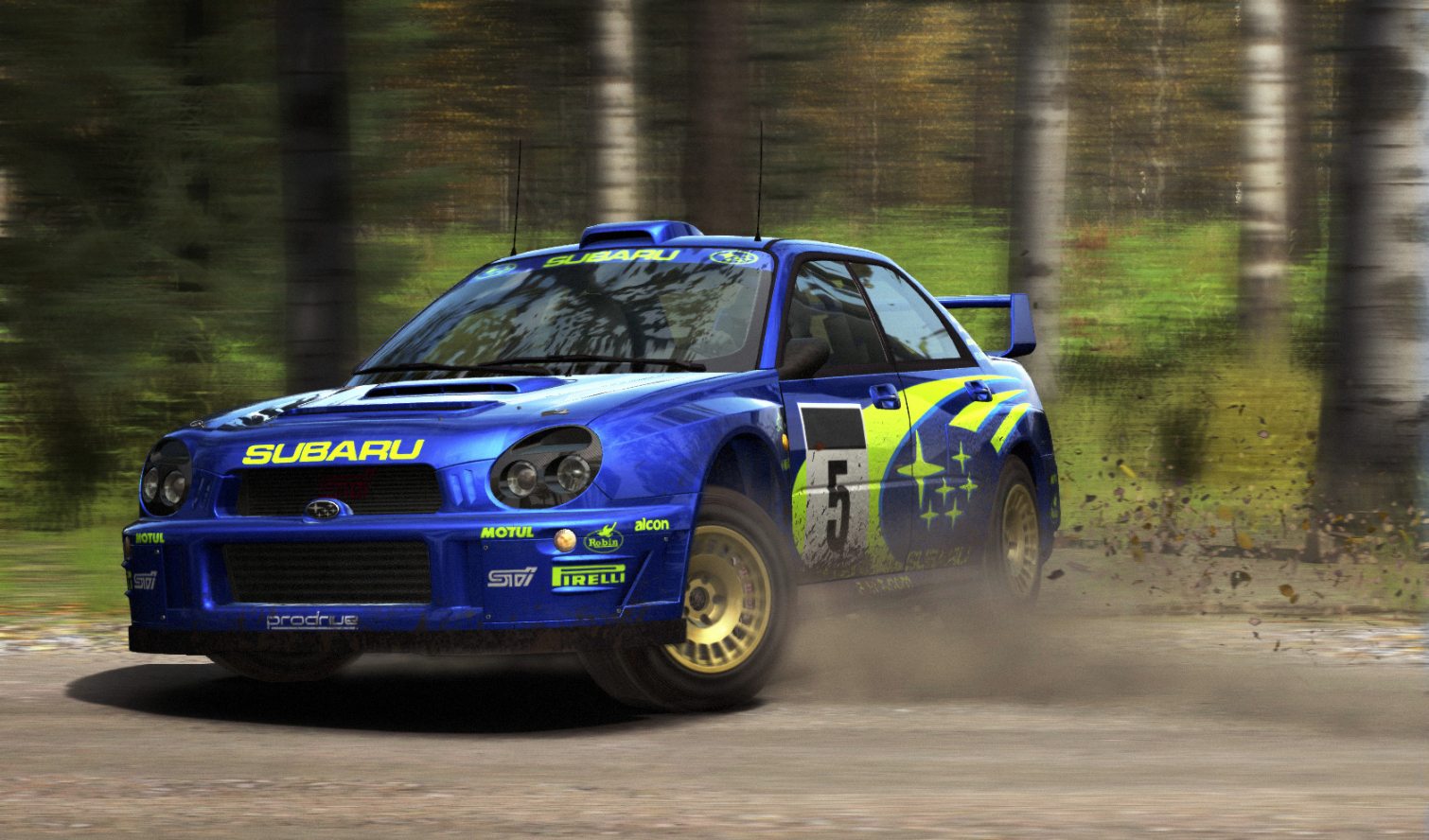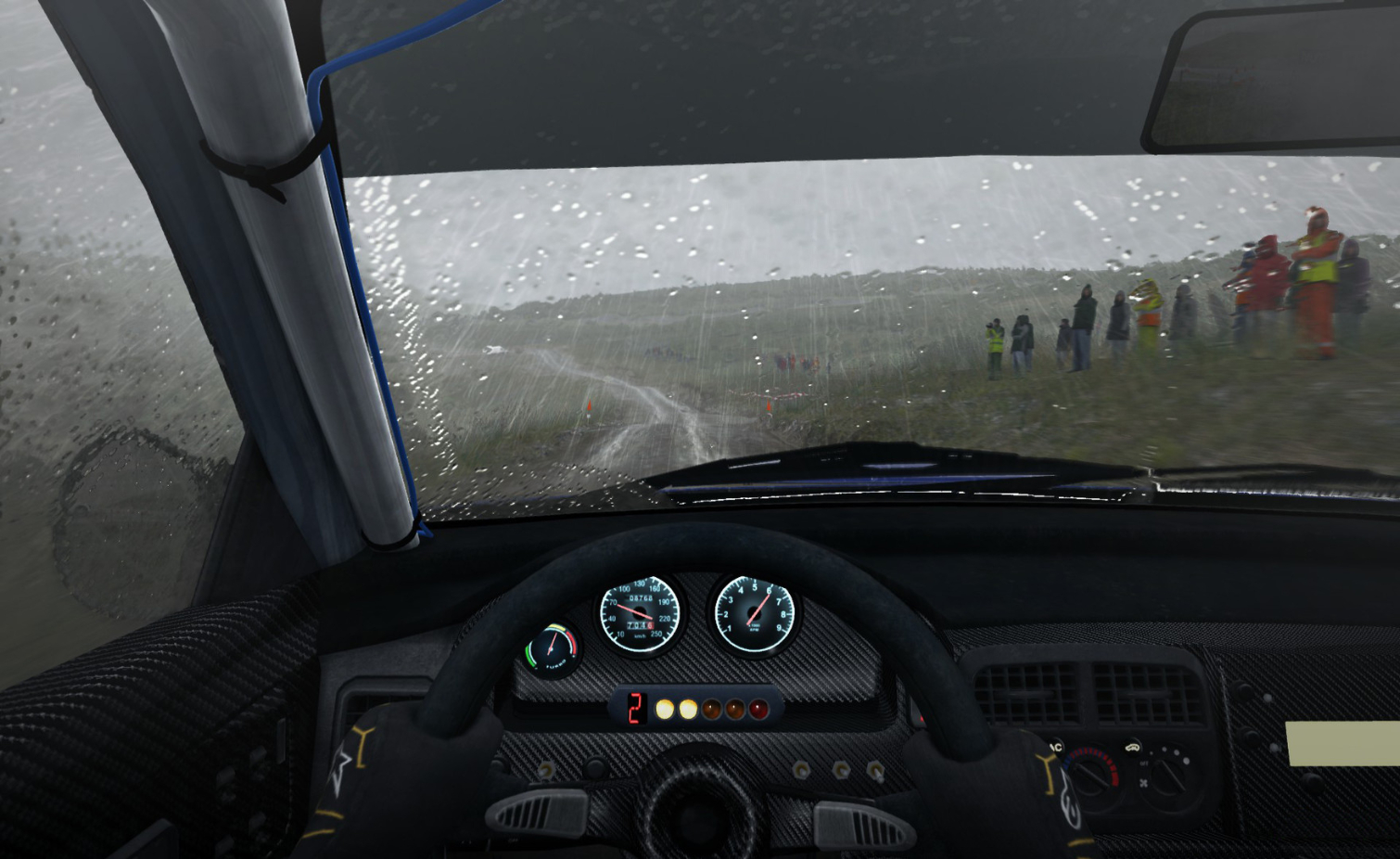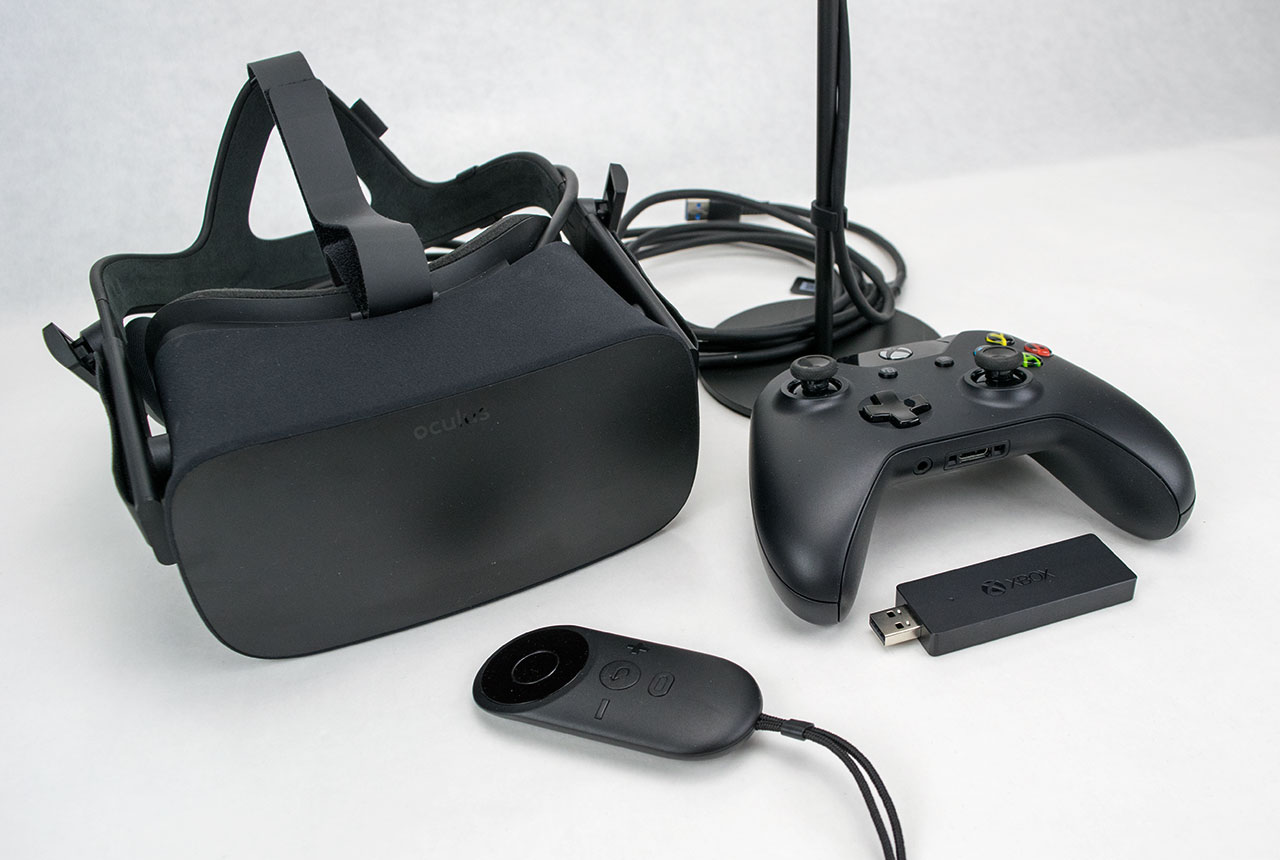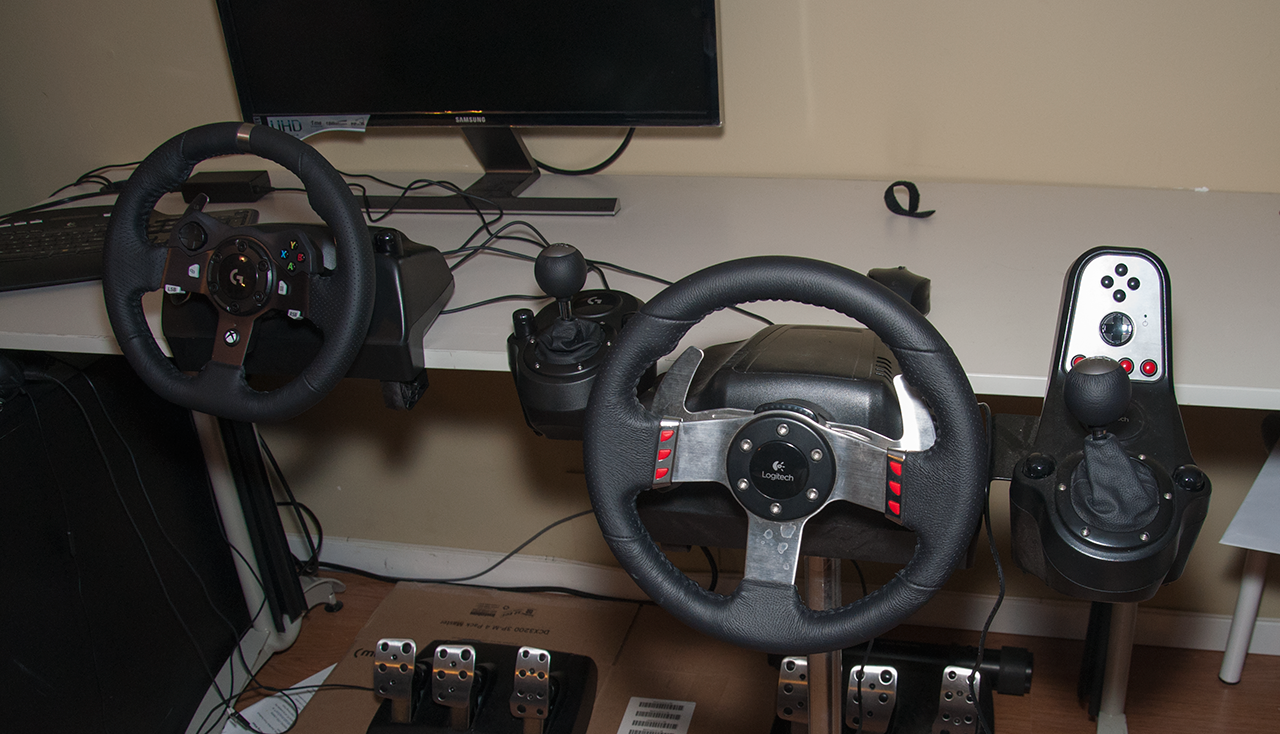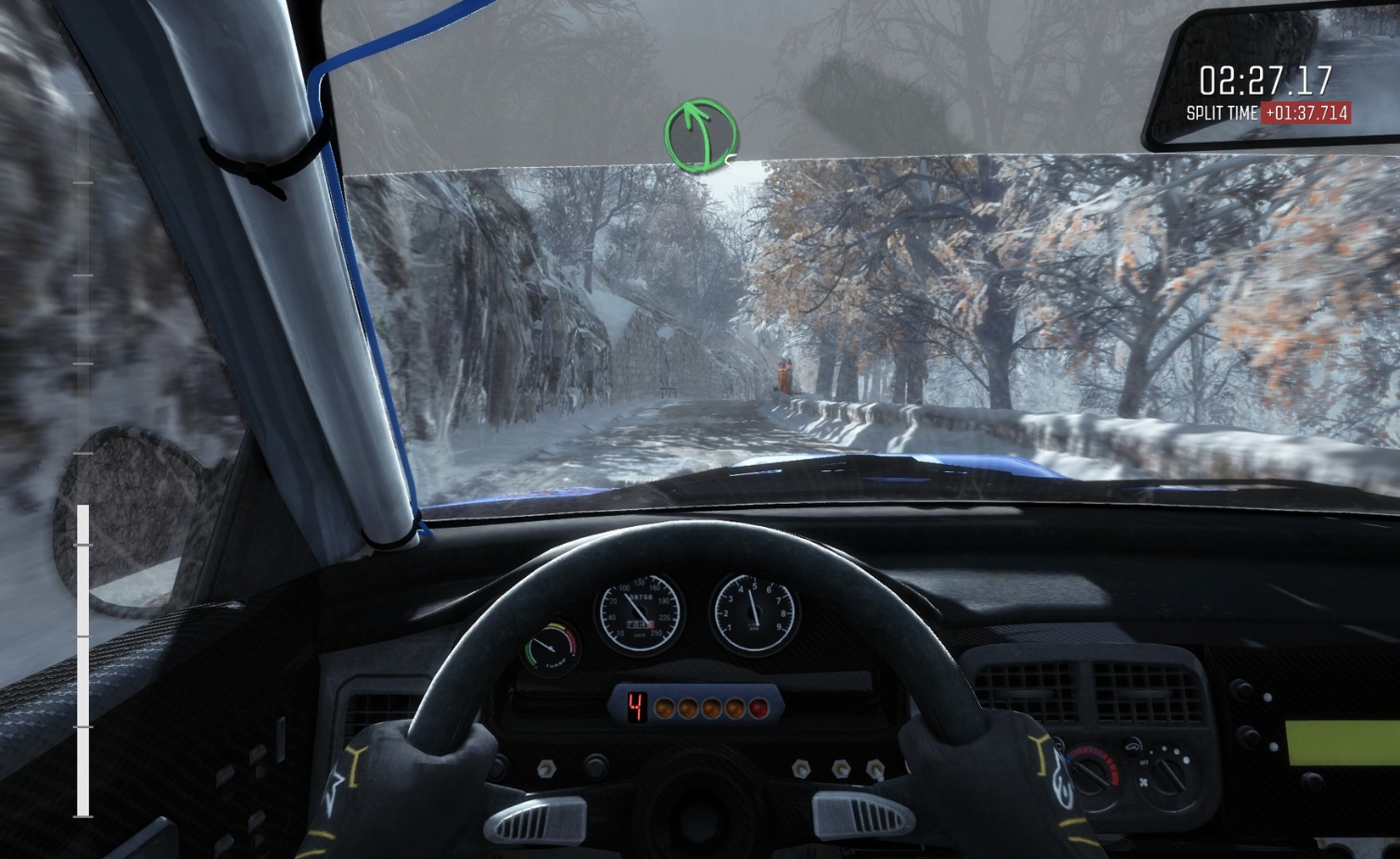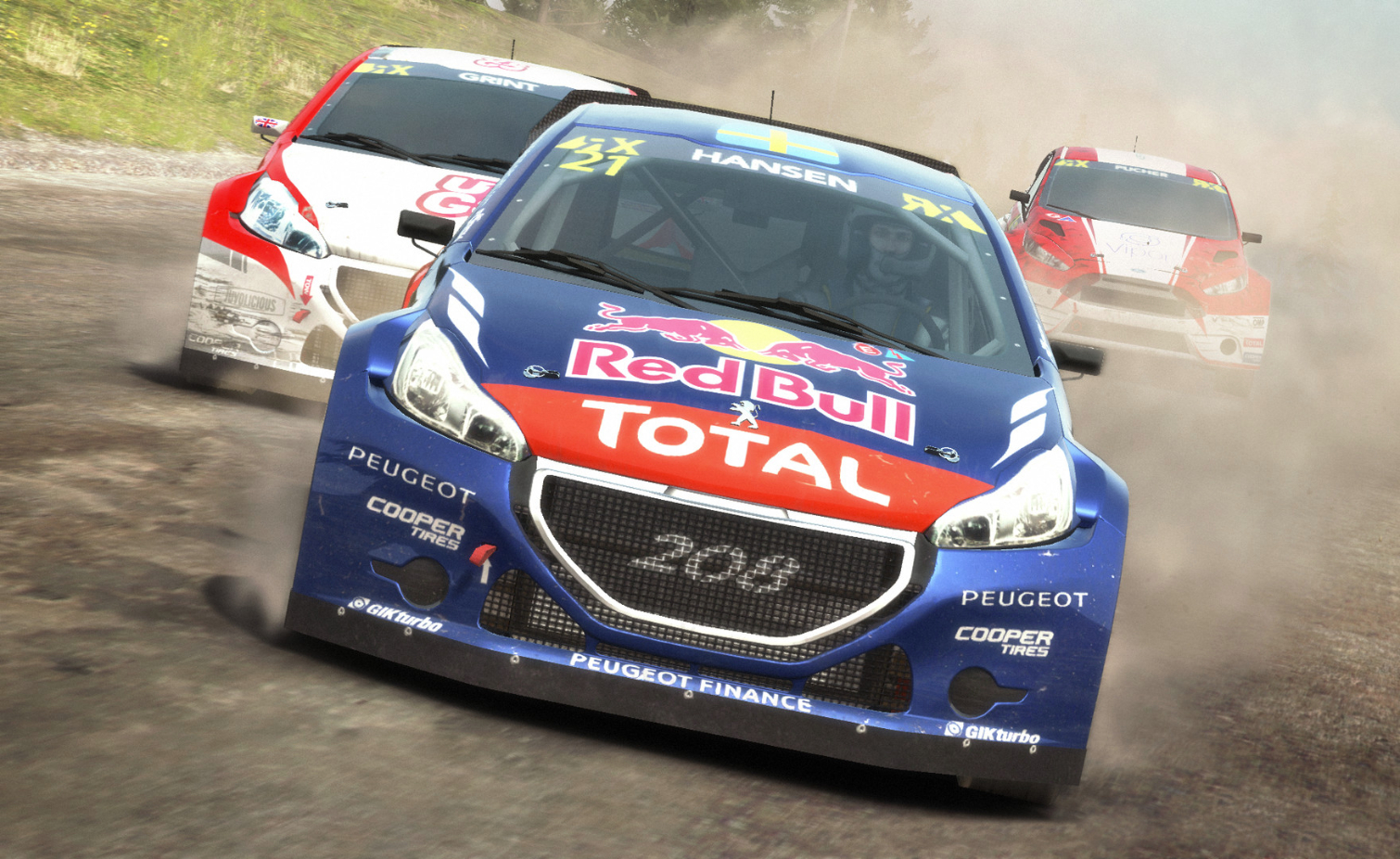Crashing Down The Mountainside: 'Dirt Rally VR' Hands-On (Updated)
“Left six over jump (maybe), 100. Right six through dip, 80. Caution left five over jump, 60. Left three, half-long, 100. Left four, continues past junction, opens. And Left five. Right four, tightens to three into immediate turn square right, don’t cut!”
If you have no idea what that means, don’t worry. I didn’t either. The moment the countdown finished and the race began, I was being bombarded with these strange, incomprehensible commands that were supposed to guide me through the path ahead at breakneck speeds. Needless to say, I died a horrible death at least a dozen times before I completed my first rally stage.
Racing in Dirt Rally isn’t like any other racing game I’ve ever played, and I’ve played a lot of them. Admittedly, my time with the Dirt series has been limited, and I’ve never so much as completed a stage in the spiritual predecessor of Dirt Rally, Colin McRae Rally, so I may have just been missing out. Ripping up a mountain as fast as you can is a frightening experience in VR. Going over the cliff was almost too much to handle, but when you get it right, the rush is incredible.
The first time that I misjudged my braking point and ran right past a hairpin corner off the edge of a cliff, I burst out into hysterical laughter. I’m pretty sure the laughter was a reaction to my mind realizing that I didn’t just die a horrible death. Going over the edge was a powerful experience.
Jokes about crashing aside, Dirt Rally VR proved to be one of the most enjoyable racing games I’ve ever played and one of the best VR games in general.
Learning your co-pilot’s lingo is the key to not repeatedly traumatizing yourself like I did. If you know what your partner is saying to you, you’ll be much more prepared for the obstacles that lie ahead, and you’ll be far less likely to go careening off the edge. It takes some time to get used to the calls, but once you figure out what some of it means, you’ll notice that you spend a lot more time on the right path and a lot less time in the bushes, ditches and tumbling down the mountainside.
I’ll give you a few hints. "One" through "six" represent how serious the bend ahead is. The higher the value, the less aggressive the turn will be. Some commands are easy to figure out: "Jump, maybe" means be prepared for a jump, but if you’re not moving fast enough, you won’t jump. It’s a helpful indicator to tell if you’re keeping up with the pace that you should be. "Caution" means there’s an obstacle around the bend that you really want to avoid hitting, such as a crowd of people spectating. The final number, usually "60," "80" or "100," represents the distance in meters to the next obstacle.
Get Tom's Hardware's best news and in-depth reviews, straight to your inbox.
Navigating The Menus
There’s a lot to consider when building a game for VR, especially if the game is being ported from a 2D screen experience. It may not be obvious if you’ve never tried VR, but how the menu navigation is set up makes a huge difference for VR games. Codemasters was smart about how it handled pre-race menu navigation. Instead of rebuilding the menu system from the ground up and stripping the cut scenes out, the developer incorporated a form of theater mode for every part of the game that isn’t actually racing. If you’re changing a setting (outside of the pause screen), selecting a championship, or watching a pre-rendered cut scene, you will find yourself in a strange gray sphere with the game window hovering in front of your face.
When a race begins, you’ll find yourself sitting inside the cockpit of your car in the first person.
Hardware Requirements
Dirt Rally started off as a game for traditional screens. Before it’s launch, Codemasters said that Dirt Rally would feature VR support, but when the game launched in early access last year, there were no VR HMDs on the market. You could get the game to work on a Rift DK2 for a time, but official Rift support was added just a couple weeks ago. Because the game was built to run on 2D screens, the graphics settings can get quite high. Don’t expect to be running maxed-out settings in VR anytime soon.
We performed our tests on a PC with an Intel Core i5-4570K and 16GB of DDR3 RAM. We tested a small selection of graphics cards, including a Gigabyte GTX 970 G1 Gaming, a Gigabyte GTX 980 Ti Xtreme Gaming, and a Gigabyte GTX 1080 G1 Gaming. We also ran tests with a Sapphire R9 390 Nitro and an XFX R9 Fury. Unfortunately, we don’t yet have a GTX 1060, RX 480 or R9 Fury X in this lab for comparison.
Per Oculus' standards, Dirt Rally VR will run on a minimum-spec VR machine, but you will have to settle for “Ultra Low” graphics details to do to that. For the “Ultra Low” preset, virtually every modern visual enhancement is turned down to the minimum, if not disabled. The result is terrain devoid of any kind of details. The ground is a bland washed-out texture, trees can barely be considered 3D, and when you’re barreling through the forest, it’s almost impossible to see upcoming bends and braking points. You really have to pay attention to your navigator when the graphics settings are this low.
Out test system wasn’t even capable of achieving 90fps consistently with the graphics settings increased to “Low.” And Codemasters tried hard to boost performance. The developer even went so far as to remove unnecessary items from the car, such as the wheels and the entire section of the vehicle behind the driver seat, so there are fewer things for the GPU to render.
Even if you have the most badass gaming rig in the world, you still won’t be turning up the graphics that much. Dirt Rally doesn’t have support for VR SLI, and it wasn’t built on AMD’s Liquid VR, so Affinity Multi-GPU isn’t going to work, either.
The best possible experience right now will be with Nvidia’s soon-to-be dethroned king, the GTX 1080. Our test system was able to handle the game at the “Medium” preset, which is a vast improvement visually over “Ultra Low,” but it’s still a far cry from the highest preset available. The “High” preset is playable, but probably not recommended. The frame rate often dipped well below the desired 90fps threshold. Our CPU may have played a role in those dips, though. An X99 or Skylake CPU might fare better than the older i5 in our test system, but it probably isn't enough to increase the graphics settings any higher. We expect you’ll need an even more powerful GPU, such as the freshly announced Pascal Titan X to push Dirt Rally to the High preset and above.
The AMD cards that we tested didn’t perform any better. With the R9 Fury installed, Dirt Rally automatically set the graphics settings to the High preset, but this proved to be unplayable in VR. The frame rate regularly dipped far below the necessary 90fps threshold. By dropping the graphics preset to medium, the performance stabilized. For the R9 390, Dirt Rally chose the Medium preset. I didn’t have to dial the settings back with this card at all.
I would suggest adding a racing wheel to your setup to complete the experience. Playing with a controller works, but if you really want to feel like you’re there in the driver’s seat, you’ll need the tactile feedback that wheel peripheral provides.
Peripheral compatibility
Like any racing game, Dirt Rally can be played with the Xbox One gamepad that comes with your Oculus Rift. Being that Dirt Rally started off as a desktop PC game, it also supports keyboard input if you prefer, but you will need the gamepad on either way because of the Oculus software’s hardware checks. If you have a copy of the game through Steam, you may not be subject to this nuisance, but if you bought it through Oculus Home, you always need a gamepad connected.
Dirt Rally supports the Xbox One controller without any additional configuration. Just fire up the game and start playing. The profile is already preconfigured correctly for the gamepad.
If you want to use a racing wheel, though, be careful. I have two racing wheel peripherals at my disposal: A Logitech G27 and a Logitech G920. The G27 has been around for several years and is a fairly common accessory among racing game fans. As such, you’d expect that Dirt Rally would have native support for this common peripheral.
When I originally set up the G27, the game detected that there was a Logitech wheel installed, but it was detected as a Driving Force wheel, not a G27. (Per the update at the bottom of this article, an astute reader correctly ascertained that it was probably a driver issue. He was right. After reinstalling the driver, the game correctly detected the G27.)
Hours And Hours Of Racing
Dirt Rally is a game built for racing fans, not for casual racers. The championships are long and grueling, and once you start one, you’re locked into until the end. The first championship consists of six races, with four to six stages in each race. Each stage features a new path to follow, and each race will have different terrains, such as snow, soft mud or hard dirt. In the first championship, each stage usually takes between four and six minutes to complete. It takes well over two hours to complete the first championship.
The cars from the first championship are all from the ‘60s. Each class moves up through the years and features the best rally cars of the era. The second championship features cars from the ‘70s, such as the Lancia Delta Integrale. There are also championships featuring iconic rally cars from the '80s, '90s, early '00s and into the modern day. Each championship is of similar length to the first one, so Dirt Rally will provide tens of hours of gameplay in the championships alone, but there are even more options.
Codemasters added hill climb to the roster of events available to you, but you’ll have to earn your way into these advanced races. Hill climb requires some of the most expensive cars the game offers, so you’ll have to complete a few championships to work your way up to those events. The cheapest hill climb car will set you back $175,000. By contrast, the first championship car will cost you $37,000 and even after placing third, I didn’t earn enough money to unlock the first hill climb car in my first championship.
You can also try your luck with online challenges. Rally racing is about beating the clock, not competing directly with another opponent in a live race, so these aren’t really played online. Instead, you get one chance to put down your best time in daily, weekly and monthly challenges, which will be ranked globally so you can compete for bragging rights.
Rallycross
Dirt Rally isn’t just about solo racing, though. The game also features a Rallycross tournament. Rallycross is more like a traditional race where you race against other cars, except it takes place on a dirt track with jumps. Each track has two routes. The quick way, which you will take most of the time, and a longer route called the Joker Lap, which everyone has to take once per race. It’s up to you to decide when to take the Joker, but you can’t skip it.
Rallycross is open to each class of rally car, so once you’ve started a championship and have a car in your garage, you can play these races.
You Should Try This Game
Dirt Rally VR is definitely an experience worth trying out. I give high praise to Codemasters for the excellent job porting Dirt Rally from 2D screens to VR HMDs. Racing up a mountainside road at breakneck speeds in virtual reality is a visceral experience. If racing games are your jam, don’t pass this one up. Dirt Rally VR is available through the Oculus Home Store. The Steam version of the game is also VR-compatible, but only with an Oculus Rift. HTC Vive is not supported at this time.
Update, July 24, 2016, 6:00pm PT: The original version of this article misstated a driver issue concerning the Logitech G27 racing wheel. One of our astute readers pointed out that Dirt Rally works fine with his G27 racing wheel and suggested that it may be a driver issue. Although I was sure I had reinstalled the driver before reporting on it, either my installation file was corrupt, or I actually forgot to reinstall the Logitech Gaming Software.
After the reader reached out, I reinstalled Logitech Gaming Software 5.10, and to my surprise the game detected the G27 wheel correctly. Furthermore, the G27 didn’t require any further tweaking or tuning to get it to work. The game found the wheel, and once the preset was selected, all of the inputs, including the gas and brake pedal, worked as they should. We have changed the article to reflect the above.
Kevin Carbotte is a contributing writer for Tom's Hardware who primarily covers VR and AR hardware. He has been writing for us for more than four years.
-
-Fran- Thanks a lot for this review!Reply
I have a question though. Do you *need* VR support for a game? Is there a problem if you want to use any HMD as a "monitor slapped to your face"? I mean, I was thinking you could add the movement tracking thingy to the axis's that move the camera and be done with it. I don't know if there's an additional thing you might need, like correcting the image for each eye or something.
Cheers! -
kcarbotte Reply18332986 said:Thanks a lot for this review!
I have a question though. Do you *need* VR support for a game? Is there a problem if you want to use any HMD as a "monitor slapped to your face"? I mean, I was thinking you could add the movement tracking thingy to the axis's that move the camera and be done with it. I don't know if there's an additional thing you might need, like correcting the image for each eye or something.
Cheers!
Glad you enjoyed it.
As to your question, yes and no.
You don't necessarily need VR support, but its not nearly as simple as stapping a screen to your face.
The image has to be warped to fit the view, the game's scaling has to be corrected for VR too.
There are some third party apps that will convert standard games, but not all games are supported by that.
The Rift and the Vive are not treated as monitors by your graphics card, so you can't even "just do it anyways."
Look up Vireio Perception and VorpX (both covered on the website) to see what I'm talking about.
-
Rhinofart So, the VR aspect of this game requires way more graphics horsepower? I play this game on the highest settings at 2560 x 1440 with my i7 980x OCed to 4.25Ghz, and my XFX R9 290x stock with zero problems at all. I have no lag, I don't know the FPS I'm getting, but I do know it's smooth, and doesn't lag what so ever.Reply -
rhysiam Reply18333103 said:So, the VR aspect of this game requires way more graphics horsepower? I play this game on the highest settings at 2560 x 1440 with my i7 980x OCed to 4.25Ghz, and my XFX R9 290x stock with zero problems at all. I have no lag, I don't know the FPS I'm getting, but I do know it's smooth, and doesn't lag what so ever.
Yeah I was surprised by the performance figures reported here too. For years Codemasters have done a fantastic job of getting seriously nice look games out that don't require ultimate hardware. In terms of raw display the rift is only 2160x1200 @ 90hz, which from a raw pixel throughput perspective is significantly fewer pixels per second than a standard 1440p @ 60hz monitor (156M pps vs 221M pps).
I'd be really interested to know why the VR setup taxes the system so much more. -
kcarbotte Reply18333372 said:18333103 said:So, the VR aspect of this game requires way more graphics horsepower? I play this game on the highest settings at 2560 x 1440 with my i7 980x OCed to 4.25Ghz, and my XFX R9 290x stock with zero problems at all. I have no lag, I don't know the FPS I'm getting, but I do know it's smooth, and doesn't lag what so ever.
Yeah I was surprised by the performance figures reported here too. For years Codemasters have done a fantastic job of getting seriously nice look games out that don't require ultimate hardware. In terms of raw display the rift is only 2160x1200 @ 90hz, which from a raw pixel throughput perspective is significantly fewer pixels per second than a standard 1440p @ 60hz monitor (156M pps vs 221M pps).
I'd be really interested to know why the VR setup taxes the system so much more.
VR doesn't need an average of 90fps, it requires a minumum of 90fps.
There's big difference there. When the game dips to 60fps, even for a moment, its very discernable in a VR HMD.
You also got your math wrong.
2160x1200 @ 60Hz = 156M pps
2560*1440 @ 60Hz = 221M pps
2160x1200 @ 90Hz = 233M pps
But you also have to consider that the GPU can't let the frame rate drop, so it would actually average well above 90fps if frame synchronization wasn't in the picture.
VR is just hard on your GPU. -
GR33kFR34k I’ll give you a few hints. "One" through "six" represent how serious the bend ahead is. The higher the value, the more aggressive the turn will be."Reply
I'm pretty sure this is the other way around. -
rhysiam Reply
Thanks for the response. Epic maths fail there on my part... that's embarrassing!18333573 said:VR doesn't need an average of 90fps, it requires a minumum of 90fps.
There's big difference there. When the game dips to 60fps, even for a moment, its very discernable in a VR HMD.
You also got your math wrong.
2160x1200 @ 60Hz = 156M pps
2560*1440 @ 60Hz = 221M pps
2160x1200 @ 90Hz = 233M pps
But you also have to consider that the GPU can't let the frame rate drop, so it would actually average well above 90fps if frame synchronization wasn't in the picture.
VR is just hard on your GPU.
I hear you about the minimums and I can't seem to find any benchmark list that reports minimum fps, but according to hardware.info even the lowly gtx 960 can average 120fps at medium settings at 1440p. Maybe there are frequent dips below 90fps, I don't know. Irrespective, it seems fair to conclude that a 960 provides a fantastic experience at medium settings on a 1440P @ 60hz monitor, yet the roughly 3 x faster 1080 has to settle on the same medium detail settings for VR, despite the similar pixel-per-second demands of each display.
I suppose what I'm actually wondering is whether VR is inherently more demanding than a 1440P @ 60hz display, or is it just that we need to shift from average to minimum fps to gauge VR performance? If you measure raw FPS, is VR similar to 1440P?
I realise this is a news post not a full review, so not expecting concrete testing/answers here. But given the rise of VR, I'd certainly be interested in this featuring in future articles, particularly alongside the CPU aspects (which you mention as a possible culprit for the 1080 results). What's the impact of positional tracking on the CPU? Do more cores help? All interesting questions which I don't believe have been explored much as yet... if they have, post me some links! -
rhysiam Reply18333619 said:I’ll give you a few hints. "One" through "six" represent how serious the bend ahead is. The higher the value, the more aggressive the turn will be."
I'm pretty sure this is the other way around.
Yeah you're correct.
I actually always thought it was the recommended gear to take the corner in assuming a 6 speed gearbox, but it turns out that's not quite right: http://blog.codemasters.com/dirt/04/co-driver-calls-explained/
In any case, 6 = fast corner, 1 = slow -
kcarbotte Reply18333619 said:I’ll give you a few hints. "One" through "six" represent how serious the bend ahead is. The higher the value, the more aggressive the turn will be."
I'm pretty sure this is the other way around.
You're right. it's been amended.
-
kcarbotte Reply18333694 said:
Thanks for the response. Epic maths fail there on my part... that's embarrassing!18333573 said:VR doesn't need an average of 90fps, it requires a minumum of 90fps.
There's big difference there. When the game dips to 60fps, even for a moment, its very discernable in a VR HMD.
You also got your math wrong.
2160x1200 @ 60Hz = 156M pps
2560*1440 @ 60Hz = 221M pps
2160x1200 @ 90Hz = 233M pps
But you also have to consider that the GPU can't let the frame rate drop, so it would actually average well above 90fps if frame synchronization wasn't in the picture.
VR is just hard on your GPU.
I hear you about the minimums and I can't seem to find any benchmark list that reports minimum fps, but according to hardware.info even the lowly gtx 960 can average 120fps at medium settings at 1440p. Maybe there are frequent dips below 90fps, I don't know. Irrespective, it seems fair to conclude that a 960 provides a fantastic experience at medium settings on a 1440P @ 60hz monitor, yet the roughly 3 x faster 1080 has to settle on the same medium detail settings for VR, despite the similar pixel-per-second demands of each display.
I suppose what I'm actually wondering is whether VR is inherently more demanding than a 1440P @ 60hz display, or is it just that we need to shift from average to minimum fps to gauge VR performance? If you measure raw FPS, is VR similar to 1440P?
I realise this is a news post not a full review, so not expecting concrete testing/answers here. But given the rise of VR, I'd certainly be interested in this featuring in future articles, particularly alongside the CPU aspects (which you mention as a possible culprit for the 1080 results). What's the impact of positional tracking on the CPU? Do more cores help? All interesting questions which I don't believe have been explored much as yet... if they have, post me some links!
VR games are generally more demanding, and it has a lot to do with correcting for lens distortion. VR games are often rendered at 1.4x the output resolution to help with image clarity. We touch on this in the Oculus Rift review. http://www.tomshardware.com/reviews/oculus-rift-virtual-reality-hmd,4506-6.html
Your suggestions for future articles are all questions I'm desperate to answer for you guys. At this time there aren't any proper tools to run benchmarks like this in VR that record the data. We're working on it, though. Keep your eyes peeled for more on this topic. We'll have more in the near future.
